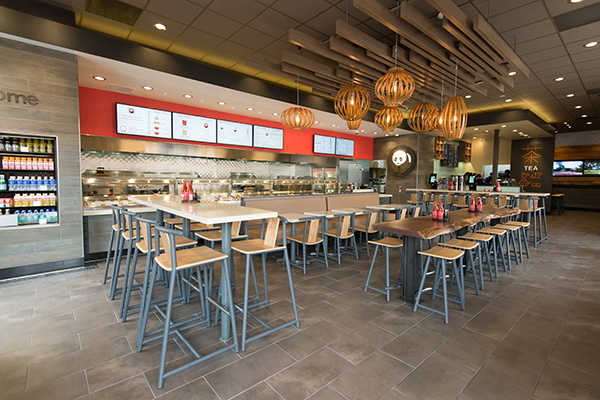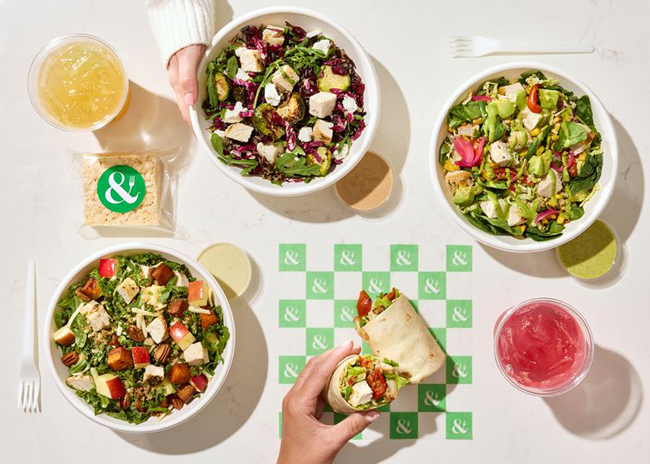Q&A with the Vice President of Restaurant Development, Panda Restaurant Group
 In her first job out of college, for an interior design firm in Muscat, Oman, Tabassum Zalotrawala worked on ultra-high-end projects in the Middle East, including the Grand Mosque and guest palaces of Sultan Qaboos. Trained as an architect and interior designer and fluent in four languages, she later moved to the United States to pursue an MBA in International Business at Emory University’s Goizueta Business School. Since then Zalotrawala has found her niche in the chain restaurant industry, beginning at Arby’s, where she became senior director of store planning. Three years ago, Zalotrawala joined Los Angeles-based Panda Restaurant Group (PRG), parent company of the fast-growing, 1,700-plus-unit QSR brand Panda Express, as well as the smaller Panda Inn and Hibachi-San Japanese Grill concepts.
In her first job out of college, for an interior design firm in Muscat, Oman, Tabassum Zalotrawala worked on ultra-high-end projects in the Middle East, including the Grand Mosque and guest palaces of Sultan Qaboos. Trained as an architect and interior designer and fluent in four languages, she later moved to the United States to pursue an MBA in International Business at Emory University’s Goizueta Business School. Since then Zalotrawala has found her niche in the chain restaurant industry, beginning at Arby’s, where she became senior director of store planning. Three years ago, Zalotrawala joined Los Angeles-based Panda Restaurant Group (PRG), parent company of the fast-growing, 1,700-plus-unit QSR brand Panda Express, as well as the smaller Panda Inn and Hibachi-San Japanese Grill concepts.
rd+d: Describe your role at PRG and the company’s development priorities.
TZ: I oversee four development functions, including architecture and design, construction, facilities and strategic sourcing. It’s really a fantastic time to be at Panda because of the tremendous growth and development the company is experiencing. We’re building about 120 Panda Express stores in 2014 and will do the same, if not more, in 2015. We’re also remodeling our facilities at a very aggressive pace — around 100 stores this year. We’re growing fast and elevating the brand at the same time to draw more guests in, which is really exciting.
rd+d: The Panda Express remodel initiative is part of PRG’s 2020 vision to nurture “guest love.” What’s that about?
TZ: Every department is focused on generating guest love by serving food with passion and ambiance with pride. On the development side, the aspect that we can really touch is ambiance with pride by elevating the look and feel of our stores. One of our priorities this year and next is to continually evolve the new prototype that we introduced two years ago. Panda Express is a 31-year-old concept and, while our facilities aren’t in poor shape, we’re proactively updating our brand image and enhancing the experience for guests. So while there’s a tremendous amount of growth right now, we’re also ensuring that we are evaluating strategies with which we can increase our same-store transactions and sales. It’s a three-pronged approach of elevating our ambiance, elevating our food options, and elevating our service.
rd+d: How does the new Panda Express Innovation Kitchen concept store factor into the quest for guest love?
TZ: It’s a prime example of how we’re constantly looking to live our 2020 vision. It’s all about innovation and finding ways to get better and become loved by our guests. For example, in the Innovation Kitchen we’re testing a new specialty tea bar as well as new menu items such as scallion pancake wraps and salads that guests can customize. The Innovation Kitchen is a place where we can test great ideas both for food and ambiance, execute them well, figure out what really works and then roll them out throughout our portfolio, all with the idea of creating more guest love and ultimately more sales and transactions. One of the great things about Panda is that we’re able to move things out into the system fairly swiftly because the majority of our stores, at least domestically and excluding some licensed units in nontraditional venues, are corporate-owned.
rd+d: What are some highlights of recent prototype design changes?
TZ: For the new prototype, we worked very closely with our branding and marketing team to identify and embrace our brand identity and personality. What you’ll find in our stores are natural and authentic finishes and a vibrant, happy environment. For our Innovation Kitchen store, we’re also testing, for the first time, custom-designed furniture that we feel reflects our unique American-Chinese brand essence.
rd+d: How much of PRG’s design and development work is handled in-house?
TZ: While we do work with outside design consultants on specific projects, we have a well-rounded in-house design team and do most of the creative brand work internally. We also have an extensive facilities team. Many other chains outsource facilities management, but we have more than a dozen facilities managers strategically located in all Panda markets across the nation who maintain our facilities and ensure that brand standards are upheld as our stores age. For construction, we have a team of project managers to support our unit opening schedules throughout the U.S. and in Canada, which is a company-owned market. We also have a team dedicated to strategic sourcing of FF&E and that provides design- and construction-related support to international franchisees and domestic licensees.
rd+d: How are you meeting the challenges of construction and project management in the face of such rapid Panda Express unit growth?
TZ: As we head into new markets, such as in the Northeast, we often have to find new local contractors but whenever possible we work with companies in our preferred GC program. This is a select group that has done business with us, knows our brand and quality requirements, and can meet our needs with few or even zero change orders. For project management, it’s all about communication, particularly between the triad of project manager, real estate manager and design manager. They collaborate closely to ensure that whatever the design team is working on can be implemented in the field without delaying the project. We do weekly status update calls and use project management software as our primary day-to-day information exchange tool.
rd+d: What are the toughest challenges you face in the current environment?
TZ: Keeping the cost and duration of construction down. The cost of materials and labor keeps going up as does the time required for permitting and doing due diligence. If you look at the development cycle now compared to even five years ago, the complexity of the real estate deals and approvals processes has extended really beyond my understanding, frankly. Five years ago, we had about a two-month timeline for permitting. Now, in many states we’re looking at nine months. Another big challenge is keeping the cost of our FF&E package down as we innovate and update our concept. The only way to do it is by strategically sourcing and getting a handle on economies of scale. It’s a constant process of value engineering and perfecting our systems to stay fresh and relevant while also keeping our development costs down.
rd+d: Sounds like a recipe for a few sleepless nights.
TZ: Juggling such challenges while keeping up with the pace of our growth and keeping innovation at the forefront can definitely keep me up at night, but it’s a good thing. It’s super exciting to be part of what’s happening at Panda. We have a fantastic team, we’re developing people and our brand beyond the U.S. borders. It’s a great place to be.




